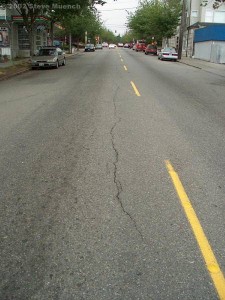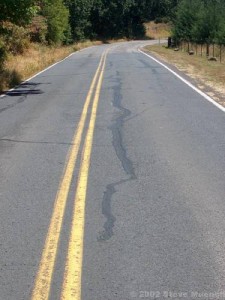Longitudinal Cracking
Cracks parallel to the pavement’s centerline or laydown direction. Usually a type of fatigue cracking.

Longitudinal cracking on a city arterial. Its location in the wheelpath indicates that is probably the onset of fatigue cracking.

Longitudinal cracking on a rural county road. Its location in the wheelpath indicates that is probably the onset of fatigue cracking possibly caused by a thin pavement structure.
Problem
Allows moisture infiltration, roughness, indicates possible onset of fatigue cracking and structural failure.
Possible Causes
- Poor joint construction or location. Joints are generally the least dense areas of a pavement. Therefore, they should be constructed outside of the wheelpath so that they are only infrequently loaded. Joints in the wheelpath will general fail prematurely.
- A reflective crack from an underlying layer (not including joint reflection cracking).
- HMA fatigue (indicates the onset of future fatigue cracking).
- Top-down cracking.
Repair
Strategies depend upon the severity and extent of the cracking:
- Low severity cracks (< 1/2 inch wide and infrequent cracks). Crack seal to prevent (1) entry of moisture into the subgrade through the cracks and (2) further raveling of the crack edges. HMA can provide years of satisfactory service after developing small cracks if they are kept sealed (Roberts et. al., 1996).
- High severity cracks (> 1/2 inch wide and numerous cracks). Remove and replace the cracked pavement layer with either a patch as a temporary fix or rehabilitate with an overlay.
Surface Distresses



